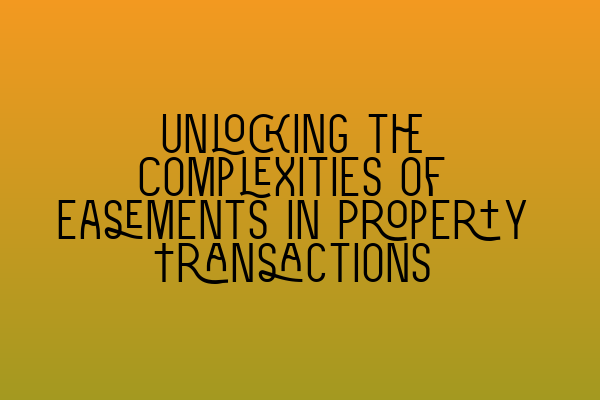Unlocking the Complexities of Easements in Property Transactions
When it comes to property transactions, there are many legal aspects that need to be considered. One particular area that often confuses people is easements. Easements are a legal right that allows one party, known as the dominant owner, to use part of another party’s property, known as the servient land. Understanding the complexities of easements is crucial for property law practitioners and landowners alike. In this article, we will delve into the intricacies of easements and explore the different types, creation, and termination of easements.
Types of Easements
Easements come in various forms, each with its own characteristics and implications. The two most common types of easements are:
1. Affirmative Easements: These easements give the dominant owner the right to perform specific actions on the servient land. For example, a right of way easement allows the dominant owner to pass through the servient land.
2. Negative Easements: These easements restrict the servient landowner from performing certain activities on their property. For instance, a negative easement may prevent the servient landowner from building structures that would obstruct the dominant owner’s view.
It is important to understand the differences between these two types of easements, as the rights and obligations of the parties involved can vary significantly.
Creation of Easements
Easements can be created in several ways, and it is crucial to follow the correct legal procedures to ensure their validity. The most common methods of creating easements are:
1. Express Grant: This occurs when the servient landowner voluntarily grants an easement to the dominant owner through a legally binding document, such as a deed or agreement. It is essential for both parties to clearly express their intentions and obligations in the grant.
2. Implied Easement: Implied easements are created when the circumstances surrounding the property transaction indicate that the parties intended for an easement to exist. Common examples of implied easements include a right of way to access a landlocked property or a drainage easement.
3. Prescription: A prescriptive easement arises when the dominant owner has continuously and openly used another person’s land for a specific period, usually 20 years or more, without the servient landowner’s permission. This method is analogous to adverse possession, where someone can acquire ownership of land through continuous occupation.
Termination of Easements
Just as easements can be created, they can also be terminated or extinguished. The most common ways in which easements can come to an end include:
1. Express Release: If both parties agree, an easement can be formally released by executing a deed of release. This should be done with the assistance of a solicitor to ensure that the termination is legally enforceable.
2. Merger: If the dominant and servient estates are merged into a single ownership, such as when the dominant owner acquires the servient land, the easement is extinguished. This occurs because an easement cannot exist between the same owner’s properties.
3. Abandonment: If the dominant owner demonstrates a clear intention to abandon their rights under the easement and stops using it for an extended period, the easement may be deemed terminated. However, the burden lies on the servient landowner to prove abandonment.
Conclusion
Easements play a crucial role in property transactions and can have a significant impact on both parties involved. Understanding the complexities surrounding easements is essential for property law professionals and landowners.
If you require further information or guidance on easements or any other property law matters, our expert team at SQE Property Law & Land Law is here to assist you. We offer comprehensive courses and preparations for the SQE 1 and SQE 2 examinations, as well as a range of practice exams and mock tests. Stay updated with the latest SRA SQE exam dates and start your preparation journey today.
Related Articles:
– SQE 1 Practice Exam Questions
– SQE 1 Practice Mocks FLK1 FLK2
– SQE 2 Preparation Courses
– SQE 1 Preparation Courses
– SRA SQE Exam Dates
